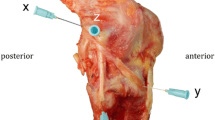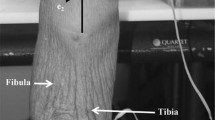Summary
In order to evaluate the contribution of both anterior (ACL) and posterior cruciate ligaments (PCL) in antero-posterior knee laxity, mechanical tests were performed on 31 fresh-cadaverknees ranging from 20 to 68 years old. The joints flexed at 90° in a mounting apparatus were placed in a testing machine with the tibia fixed in neutral rotation. The load-displacement curves were then analyzed. The results showed that the tensile strength of the ACL decreased greatly with age whereas its stiffness measured during anterior drawer test remained independent of age and sex. Successive resection of the antero-medial (AM) and postero-lateral (PL) bundles of the ACL demonstrated the AM bundle to be the major structure involved in the limitation of tibial displacement in the anterior drawer test. The amount of tibial shift during the anterior drawer test did not reflect the condition of the ACL, while its resection always induced a strong and significant drop in anterior knee stiffness. Dissection of the PCL was always followed by significant posterior tibial displacement during the posterior drawer test of over 10 mm, which did not permit the experimental apparatus to quantify the posterior load displacement relationship.
Résumé
Dans le but d'étudier la contribution du pivot ligamentaire central du genou — ligament croisé antéro-externe (LCAE) et ligament croisé postéro-interne (LCPI) — dans la stabilité antéro-postérieure de cette articulation, le rôle respectif des deux ligaments croisés a été étudié sur 31 genoux de cadavres frais fléchis à 90°, sans rotation tibiale, placés sur un montage dans une machine d'essais. Cette étude a permis de démontrer que la résistance à la traction du LCAE décroît fortement avec l'âge, tandis que la rigidité ligamentaire en tiroir antérieur direct (TAD) est indépendante de l'âge et du sexe. La section successive des faisceaux antéro-interne (AI) et postéro-externe (PE) du LCAE montre que, dans les conditions expérimentales de cette étude, seul le faisceau AI joue un rôle important dans la laxité en TAD. Si la seule mesure de l'amplitude du TAD à 90° ne permet pas de préjuger de l'état anatomique du LCAE, par contre, la section complète du LCAE entraîne toujours une chute importante et significative de la rigidité ligamentaire en TAD. La section du LCPI entraîne toujours un important tiroir postérieur, supérieur à 10 cm ce qui n'a pas permis avec la méthode utilisée de quantifier la relation force-déplacement postérieur.
Similar content being viewed by others
Réferences
Butler, D. L., Noyes, F. R., Grodd, E. S.: Ligamentous contributions to A–P stability in the knee. Biomechanics Symposium ASME, 217–220 (1978)
Butler, D. L., Noyes, F. R., Grood, E. S.: Ligamentous restraints to anterior-posterior drawer in the human knee. J. Bone Joint Surg. 62A 259–270 (1980)
Dorlot, J. M., Ait Ba Sidi, M., Tremblay, G. M., Drouin, G.: Loadelongation behavior of the canine anterior cruciate ligament. J. Biomech. Eng. 102 190–193 (1980)
Dorlot, J. M.; Christel, P., Meunier, A., Witvoet, J.: The displacement of the bony insertion sites of the anterior cruciate ligament during the flexion of the knee, in „Biomechanics: principle and applications“, pp. 185–190. Martinus Nijhoff Publ. The Hague: Huiskes, Van Campen, De Wijn (1982)
Furman, W., Marshall, J. L., Girgis, F. G.: The anterior cruciate ligament. A functional analysis based on postmorte studies. J. Bone Joint Surg. 58-A 179–185 (1976)
Hughston, J. C., Andrews, J. R., Cross, M. J.; Moschi, A.: Classification of the knee ligament instabilities. Part I: the medial compartment and cruciate ligaments. J. Bone Joint Surg. 58A 169–172 (1976)
Kennedy, J. C., Fowler, P. J.: Medial and anterior instability of the knee. J. Bone Joint Surg. 53 A 1257–1270 (1971)
Kochan, A., Markolf, K. L., Amstutz, H. C., Marquette, S. H.: Measurements of A–P stability in patients with documented absence of the anterior cruciate ligaments. 27th Ann. O.R.S. p. 5. Las Vegas: (1981)
Markolf, K. L., Mensch, J. S., Amstutz, H. C.: Stiffness and laxity of the knee. The contribution of the supporting structures. J. Bone Joint Surg. 58-A 583–594 (1976)
Markolf, K. L., Graff-Radford, A., Amstutz, H. C.: In vivo knee stability. J. Bone Joint Surg. 60-A 664–674 (1978)
Marshall, J. L., Wang, J. B., Furman, W., Girgis, F. G., Warren, R.: The anterior drawer sign: what is it? J. Sport Med. 3 152–158 (1975)
Noyes, F. R., Grood, E. S.: The strength of the anterior cruciate ligament in humans and rhesus monkeys. J. Bone Joint Surg. 58-A 1074–1082 (1976)
Noyes, F. R., Grood, E. S., Butler, D. L., Paulos, L. E.: Clinical biomechanics of the knee — ligament restraints and functional stability. Symposium on the Athlete's knee: Surgical repair and reconstruction. Saint-Louis: Fung and Mosby (1981)
Piziali, R. L., Rastegan, J., Nagel, D. A., Schuman, D. J.: The contribution of the cruciate ligaments to the load-displacement characteristics of the human knee joint. J. Biomed. Engng. 102 277–283 (1980)
Torg, J. S., Conrad, W., Kalen, V.: Clinical diagnosis of anterior cruciate ligament instability in the athlete. Am. J. Sport Med. 4 84–93 (1976)
Torzilli, P. A., Grenberg, R. L., Insall, J.: An in vivo biomechanical evaluation on anterior-posterior motion of the knee. J. Bone Joint Surg. 63-A 960–968 (1981)
Author information
Authors and Affiliations
Additional information
Travail du Laboratoire de Recherches Orthopédiques de la Faculté de Médecine Lariboisière-Saint-Louis et du Service de Chirurgie Orthopédique de l'Hôpital Saint-Louis.
Rights and permissions
About this article
Cite this article
Dorlot, J.M., Christel, P., Meunier, A. et al. Analyse du rôle mécanique des ligaments croisés dans la laxité antéropostérieure du genou. International Orthopaedics 7, 91–97 (1983). https://doi.org/10.1007/BF00266457
Issue Date:
DOI: https://doi.org/10.1007/BF00266457




